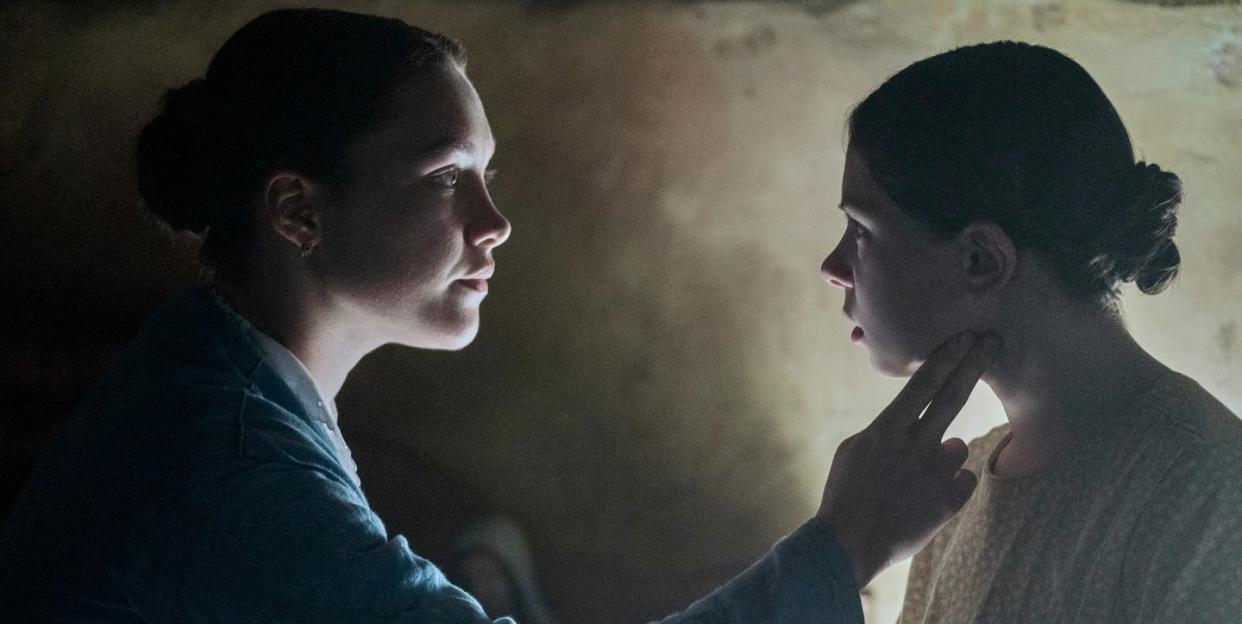Here's What the Ending of Netflix's "The Wonder" Really Means

- Oops!Something went wrong.Please try again later.
"Hearst Magazines and Yahoo may earn commission or revenue on some items through the links below."
Content warning: This article contains spoilers and references to sexual abuse some may find upsetting. Reader discretion is advised.
Netflix's latest period drama, The Wonder, showcases Don't Worry Darling and Dunes' Florence Pugh as an English Nightingale Nurse named Lib Wright, who is called by a poor, religious community to observe an 11-year-old girl named Anna (Kíla Lord Cassidy), who hasn't eaten in four months. Loosely inspired by the true story of The Great Famine of Ireland (otherwise known as The Great Hunger) that happened from 1845 to 1852, the movie and the book of the same name written by Emma Donoghue sees the patient claim she miraculously survives off of "manna from heaven." As the skeptical Nurse Lib attempts to make sense of the medical marvel that some in town consider a divine miracle, she also works to ascertain whose judgment she can trust.
The film, directed by Sebastián Lelio, innovatively tells the story, starting by breaking the fourth wall (aka what separates the performers from the audience). "Hello. This is the beginning," actress Niamh Algar, who plays Anna's older sister Kitty, says as the movie begins with a panning shot of a film equipment-filled warehouse. "The beginning of a film called The Wonder. The people you are about to meet, the characters, believe in their stories with complete devotion. We are nothing without stories. And so we invite you to believe in this one. It is 1862. We left England, bound for Ireland. The Great Famine still casts a long shadow, and the Irish hold England responsible for that devastation. There sits a nurse. An English nurse, traveling all on her own. And it's with her, we begin."
Speaking of the opening scene, Lelio said in an interview with GamesRadar+, "I thought it was important for the film itself to say to the viewer, 'Listen, you will be exposed to the power of fiction, your disbelief will be suspended. And then you will be kindly reminded that you have been, hopefully, fervently believing in the film, in the same way in which the characters are believing their own stories.'"
He added, "It is a film also about the collision between reason and magical thinking or science, and extreme religiousness; between spiritual and intellectual elasticity versus fanaticism. In that sense, this little framing is saying to the viewer, 'What do you believe in? Are you fixed in your position? Or are you willing to change, adapt, and evolve? What sort of viewer are you?'"
Below, find out what exactly happens to Lib, how Anna survives seemingly without eating, and how the community reacts, as we unpack the ending of Netflix's The Wonder.
The Wonder Ending Explained
After Lib isolates Anna from her family, the little girl begins to starve, confirming the nurse's suspicions that it was not a religious miracle. Lib realizes that Anna is surviving on food that her mom chewed and passed into her daughter's mouth through kisses. It is also discovered that the young girl was convinced to participate in a religious fast as her sexually abusive brother had died four months earlier, and Anna's mom held her responsible for her brother's death. Anna believes that by sacrificing her own life through fasting, she can save her brother from eternal damnation.
When Lib warns the council overseeing her nursing watch that Anna is dying, they do not intervene to save Anna. The girl's parents admit to nothing, hold to their religious beliefs, and accept that their daughter is dying. The clergy council agrees with the parents and insists that the experiment be continued. To save Anna, Lib develops a plan with her journalist lover William (Tom Burke), to fake the girl's death. Lib gives Anna opioid-laced milk, telling her the concoction will kill 'Anna' and that she will be reborn as a new little girl named Nan. Once unconscious, William takes Anna to hide by a secret lake while Lib burns down Anna's home, even injuring herself to make the story more believable. After telling the council that the girl has died, Lib meets up with Will and Anna. The last scene shows Lib, Will, and Anna (now Nan) on a ship bound for Australia. They're sitting at dinner, and Anna is apprehensively eating.
The screen then pans away from the ship scene, pulling back to show the film's set. Algar, no longer dressed as her character, Kitty is standing in all black. She says, in a hushed tone, "In. Out. In. Out."
These four words reference the thaumatrope that Will shows Anna earlier in the film, of a bird who seems both inside a cage and free simultaneously. "Is it trapped, or is it free?" Anna asks Will when he shows her the optical toy. Will responds, "That's for you to decide. Inside. Outside. Inside. Outside." As the image of the thaumatrope fades away, Anna echoes what he says, saying, "In. Out. In. Out,"
Lelio explained to GamesRadar+ that the point of the beginning and ending shots in the modern studio is to convey how the story resonates in modern times. "To talk about the opening and the role that Kitty plays, that consciousness, self-awareness of the film, it's also a way of saying, 'Of course, this is not really 1862.' It might be evident to say it, but let's say it because the characters are fictional, but what they represent is not. And the power dynamics might have happened in the 1860s, but they are completely resonant with the power dynamics that are still operating today. So we are somehow trapped in the same sort of storytelling. The opening and the ending is a way of saying, 'This is today. This is now.'"
You Might Also Like

